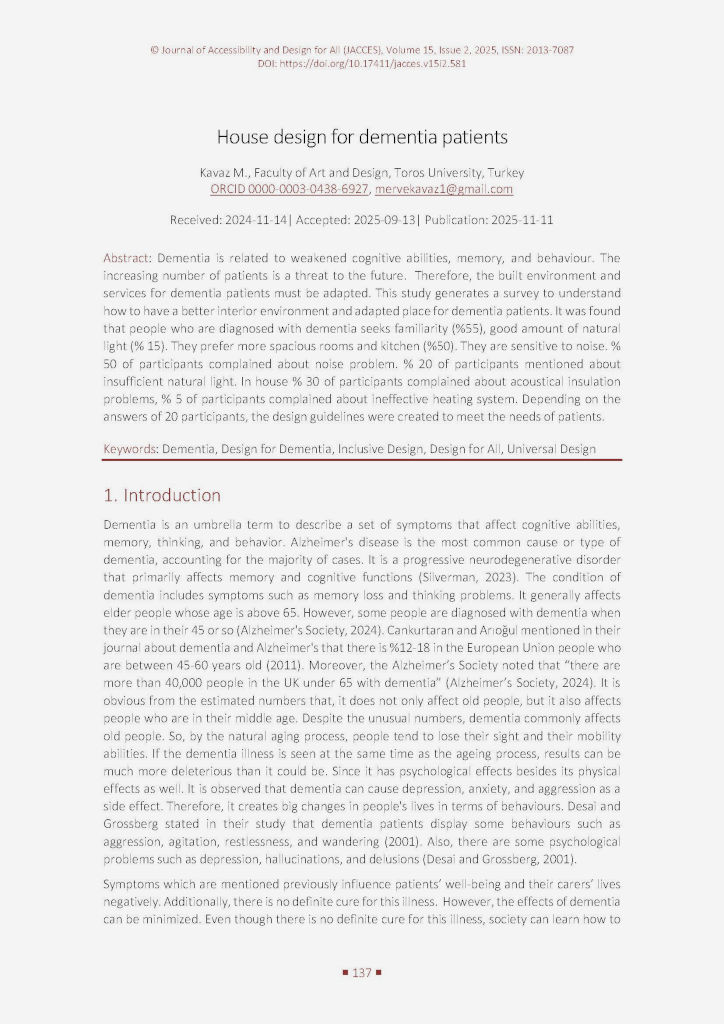House Design For Dementia Patients
DOI:
https://doi.org/10.17411/jacces.v15i2.581Abstract
Dementia is related to weakened cognitive abilities, memory, and behaviour. The increasing number of patients is a threat to the future. Therefore, the built environment and services for dementia patients must be adapted. This study generates a survey to understand how to have a better interior environment and adapted place for dementia patients. It was found that people who are diagnosed with dementia seeks familiarity (%55), good amount of natural light (% 15). They prefer more spacious rooms and kitchen (%50). They are sensitive to noise. % 50 of participants complained about noise problem. % 20 of participants mentioned about insufficient natural light. In house % 30 of participants complained about acoustical insulation problems, % 5 of participants complained about ineffective heating system. Depending on the answers of 20 participants, the design guidelines were created to meet the needs of patients.
References
Alzheimer’s Foundation of America (n.d) The Apartment. https://alzfdn.org/wp-content/uploads/2021/03/The-Apartment-Guide-web.pdf
Adams, G. , Bowes, A., McCabe, L. and Dawson, A. (n.d) Good Practice in design of homes and living spaces for people with dementia and sight loss. University of Stirling. https://social-care.org/wp-content/uploads/2023/06/Good-practice-in-the-design-of-homes-and-living-spaces-for-people-with-dementia-and-sight-loss.pdf
Alzheimer’s Society. What Causes Young- Onset Dementia?. https://www.alzheimers.org.uk/about-dementia/types-dementia/what-causes-young-onset-dementia
BBH. (2014). How small design interventions can improve the lives of dementia sufferers. https://buildingbetterhealthcare.com/how-small-design-interventions-can-improve-the-lives-of-dementia-sufferers-99727.
Bissel, K. (2010). Designing for those dementia using the principle of wayfinding.
Burton, J. (2025). Dementia Enabling Environments. https://www.enablingenvironments.com.au/about.html
Braun,A., Zanchetta, M., Hu, R., and Pawlitza, K.,(2018). MAK – Modular Assisted Kitchen for Dementia Sufferers. https://www.researchgate.net/profile/Rongbo-Hu/publication/324571467_MAK_-_Modular_Assisted_Kitchen_for_Dementia_Sufferers/links/5b0c4f22a6fdcc8c25364a75/MAK-Modular-Assisted-Kitchen-for-Dementia-Sufferers.pdf
Cankurtaran, M and Arıogul, S “Demans ve Alzheimer Hastalıgı “(2011) Mised 11-12 (2011).
Chmielewski,E. and Eastman, P. (2014). Excellence in Design: Optimal Living Space for People With Alzheimer’s Disease and Related Dementias. AFA. https://alzfdn.org/wp-content/uploads/2017/11/Excellence-in-Design-white-paper-June-2014.pdf
Cooper, C., Field, J., Goswami, U., Jenkins, R., and Sahakian,B. (2008) Mental Capital and Wellbeing. Wiley-Blackwell. https://doi.org/10.1192/BJP.BP.109.075473
Dementia Services Development Centre. (2013). Improving the design of housing to assist people with dementia. University of Stirling, 35. https://www.housinglin.org.uk/_assets/Resources/Housing/OtherOrganisation/DSDC_dementia_design.pdf
Desai, A. K., & Grossberg, G. T. (2001). Recognition and Management of Behavioral Disturbances in Dementia. in Primary care companion to the Journal of clinical psychiatry, Vol 3(3), p. 93–109. https://doi.org/10.4088/pcc.v03n0301
JAMA, (2008) Effect of Bright Light and Melatonin on Cognitive and Noncognitive Function in Elderly Residents of Group Care Facilities. http://jama.jamanetwork.com/article.aspx?articleid=273623
Karataş, Z. (2017). Sosyal bilim araştırmalarında paradigma değişimi: Nitel araştırmanın yükselişi. Türkiye Sosyal Hizmet Araştırmaları Dergisi, Vol. 1(1), p. 73. https://dergipark.org.tr/tr/pub/tushad/issue/31792/350444
Morgan Woodwork Organization. (1921). Building Assurance. Chicago, USA: Morgan. https://archive.org/details/BuildingWithAssurance/page/n5/mode/2up
PsychCentral “Improving Alzheimer’s and Dementia Care: The Eyes Have it” (2013). http://psychcentral.com/lib/improving-alzheimers-and-dementia-care-the-eyes-have-it
Raia, P. (2011) Habilitation Therapy in Dementia Care. in Age in Action. Vol. 25, No. 4. https://vcoa.chp.vcu.edu/media/chp-college-of-health-professions/vcoa/docs/age-in-action/AgeinActionFall2011.pdf
Sievert, D. (2023). Alzheimer’s Vs Dementia- What is The Difference?, https://medschool.ucla.edu/news-article/alzheimers-vs-dementia-what-is-the-difference#:~:text=In%20summary%2C%20dementia%20is%20an,own%20distinct%20causes%20and%20characteristics
T.C. Aile, Çalışma ve Sosyal Hizmetler Bakanlığı. Erişilebilirlik Kılavuzu. https://webdosya.csb.gov.tr/db/meslekihizmetler/menu/erisilebilirlik_kilavuzu_2021_20231122101955.pdf
Wikimedia Commons. (2025). https://commons.wikimedia.org/w/index.php?search=glass+kitchen+cabinet&title=Special%3AMediaSearch&type=image
Yıldırım, A. & ŞİMŞEK, H. (2005). Sosyal Bilimlerde Nitel Araştırma Yöntemleri Güncelleştirilmiş Geliştirilmiş 5. Baskı, Seçkin Yayıncılık, pp:39 , ISBN 9750200071. https://dergipark.org.tr/tr/download/article-file/63326
Zazarin, S., Aziz, Z., and Sern, C. (2023). A Study on Daylight Conditions of Dementia Care Facilities in Malaysia. Jurnal Kejuruteraan SI 6(1) 2023: 89-102. https://doi.org/10.17576/jkukm-2023-si6(1)-09

Downloads
Published
Issue
Section
License
Copyright (c) 2025 Kavaz M.

This work is licensed under a Creative Commons Attribution-NonCommercial 4.0 International License.
- Authors retain copyright and grant the journal right of first publication with the work simultaneously licensed under a Creative Commons Attribution License that allows others to share or adapt the work with an acknowledgment of the work's authorship and initial publication in this journal. Use of the work for commercial purposes are not allowed.
- Authors are able to publish the journal's published version of the work in other media (e.g., post it to an institutional repository or publish it in a book), as far as they inform the Journal of Accessibility and Design for All of that fact. When publishing their work in other sources, authors must mention the name of the Journal of Accessibility and Design for All, its ISSN, the number and issue in which the article was published and a link to the main page of the Journal of Accessibility and Design for All. Optionally, they can also include a link to the article published in the Journal of Accessibility and Design for All.
- Authors are permitted and encouraged to post their work online (e.g., in institutional repositories or on their website), as it can lead to productive exchanges, as well as earlier and greater citation of published work.

